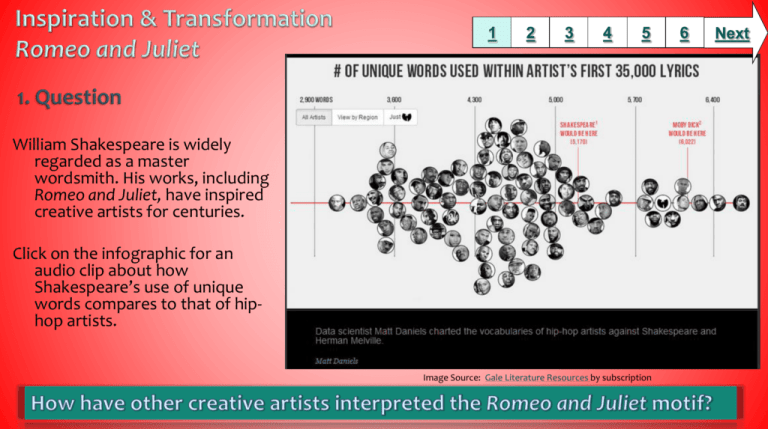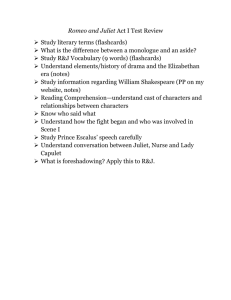
1
2
3
4
5
William Shakespeare is widely
regarded as a master
wordsmith. His works, including
Romeo and Juliet, have inspired
creative artists for centuries.
Click on the infographic for an
audio clip about how
Shakespeare’s use of unique
words compares to that of hiphop artists.
Image Source: Gale Literature Resources by subscription
6
Next
1
2
3
4
5
6
Next
Using the links below, research the story of Romeo and Juliet as
a source of literary inspiration and transformation across
cultures and across time.
Literature
Art
Music*
Cinema/ Theatre*
•
•
•
•
•
•
•
•
•
•
•
•
•
•
•
•
•
•
•
•
•
•
Legend- Marie Lu (scroll to the
bottom of the page)
Wuthering Heights- Emily
Bronte
Nicholas Nickelby- Charles
Dickens
Great Expectations- Charles
Dickens
Romiette and Julio- Sharon M.
Draper
Starcrossed- Josephine Angelini
(scroll down to Starcrossed)
•
•
•
•
•
•
Scene From Act III of ‘Romeo
and Juliet’ by William
Shakespeare
The Reconciliation of the
Montagues and the Capulets
Scene from Act II of Romeo and
Juliet
Romeo and Juliet
Oh Romeo, Oh Romeo,
Wherefore Art Thou Romeo?
Romeo and Juliet With Friar
Lawrence
Juliet
•
•
•
•
•
Love Story- Taylor Swift
Fever- Peggy Lee*
The Star-crossed Lovers- Duke
Ellington*
Romeo and Juliet- Dire Straits*
Someday We’ll Be TogetherThe Supremes*
Fire- Bruce Springsteen*
Romeo is Bleeding- Tom Waits*
Romeo had Juliet- Lou Reed*
*Some of these videos/songs may have
been published on YouTube in violation of
copyright. BCPS is not responsible for
copyright violations on YouTube. You
should consider that such violations are
not an example of ethical use of others’
intellectual property.
Warm Bodies
West Side Story
Dirty Dancing
Chinese Opera
Bellini’s Opera
Romeo + Juliet
The Notebook
High School Musical
Titanic
Atonement
Lady and the Tramp
Goliyon Ki Rasleela Ram-Leela
*These are links to summaries and
reviews. Other media related to
these articles may be accessible
online outside of school.
1
2
3
4
5
Using the resources on the previous slide,
research the story of Romeo and Juliet as
a source of literary inspiration and
transformation across cultures and
across time by locating and analyzing 3
texts, songs, artistic renderings, or other
creative works with similar plot
structures, character types, and themes.
Use the provided graphic organizer to
record your information. You must
complete one sheet for each creative
work that you select (three sheets total).
Don’t forget your bibliographic citation
and summary at the bottom!
Image Source: PBS Learning Media
6
Next
1
2
3
4
5
Using your notes from the student activity on the
previous slide, prepare an annotated
bibliography of the texts you locate. Provide an
objective summary, and note what is
emphasized or absent in each treatment.
Click here to review how to prepare an annotated
bibliography.
Be sure to review the rubric to see how your
annotated bibliography will be scored.
"Juliet” by Philip Hermogenes Calderon
Image Source: Wikimedia Commons
6
Next
1
2
3
4
5
6
Next
Just as Romeo and Juliet influenced many works,
there were some works that influenced
Shakespeare in the writing of Romeo and Juliet:
Pyramus and Thisbe- Ovid
(by subscription from Discovery Education)
Romeus and Juliet- Arthur Brooke
(view video on the left)
Today there are copyright laws to help prevent
plagiarism, but in Shakespeare’s time, no such
laws existed. Do you think that Shakespeare
would be accused of plagiarism if he wrote
Romeo and Juliet today? Write a well-developed
paragraph that defends your opinion.
Click the picture above to watch the Romeus and
Juliet video.
Video Source: Dicovery Education by subscription
1
Grade Level and Content Area
Common Core State Standards
Reading: 1. Read closely to determine what the text says explicitly and to make logical inferences from it;
cite specific textual evidence when writing or speaking to support conclusions drawn from the text.
Writing: 7. Conduct short as well as more sustained research projects based on focused questions,
demonstrating understanding of the subject under investigation.
RL.9.7 Analyze the representation of a subject or a key scene in two different artistic mediums, including
what is emphasized or absent in each treatment (e.g., Auden's "Musée des Beaux Arts" and Breughel's
Landscape with the Fall of Icarus).
RL.9.9 Analyze how an author draws on and transforms source material in a specific work (e.g. how
Shakespeare treats a theme or topic from Ovid or the Bible or how a later author draws on a play by
Shakespeare).
W.9.2 Write informative/explanatory texts to examine and convey complex ideas, concepts, and
information clearly and accurately through the effective selection, organization, and analysis of content.
Standards for the 21st Century Learner
1.1.6 Read, view, and listen for information presented in any format (e.g. textual, visual, media, digital) in
order to make inferences and gather meaning.
2.1.3 Use strategies to draw conclusions from information and apply knowledge to curricular areas, realworld situations, and further investigations.
ISTE NETS - National Educational Technology Standards for Students
3. Research and Information Fluency: Students apply digital tools to gather, evaluate, and use information.
b. Locate, organize, analyze, evaluate, synthesize, and ethically use information from a variety of
sources and media.
4. Critical Thinking, Problem Solving, and Decision Making: Students use critical thinking skills to plan and
conduct research, manage projects, solve problems, and make informed decisions using appropriate
digital tools and resources. c. Collect and analyze data to identify solutions and/or make informed
decisions.
2
3
4
5
6
Time Frame: 2 90-minute class periods.
Differentiation strategies for this lesson:
Direct students to use learning tools included in our BCPSlicensed databases, such as: audio read-aloud, labeled reading
levels/Lexiles, and embedded dictionaries.
Learning Styles addressed in this lesson:
Visual, auditory, reflective, global understanding
Notes to the teacher:
Collaborate with your school library media specialist to
implement this lesson.
You may want to collect students’ notes for a grade.
There may be several more creative works that continue the
Romeo and Juliet motif. Many of these will not be accessible at
school due to copyright and filtering issues.
Last updated: July 2015
Created by Amber Bickhart and Heather Jennings, BCPS School Library Media Interns
BCPS Slam Dunk Research Model, Copyright 2014, Baltimore County Public Schools, MD, all rights reserved. The models may be used for educational, non-profit school use only.
All other uses, transmissions, and duplications are prohibited unless permission is granted expressly. This lesson is based on Jamie McKenzie’s Slam Dunk Lesson module.







